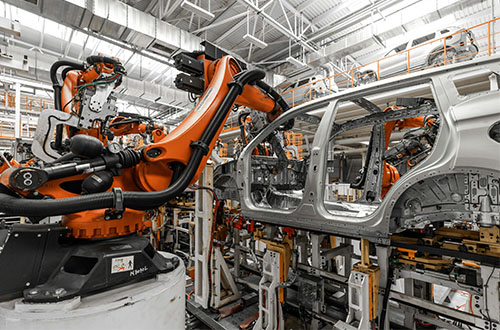

mLogica Thought Leaders: Digital Transformation: What it Means for Your Business

Peter Burney, mLogica Senior V.P. of Strategic Programs
Over the past few years “digital transformation” has become one of the hottest buzzwords in corporate culture. The changing realities of the post-pandemic landscape have propelled a large number of organizations to integrate digital capabilities throughout their business process to respond to evolving challenges and to stay competitive.
The business landscape has changed drastically post-COVID-19, and most private and public sector organizations now realize they need to capitalize on advanced technologies to optimize and future-proof their operations. This means every business needs to benchmark its technology stack and strategically level up in order to compete with digitally enabled competitors. The trick? To modernize mainframe and distributed workloads as fast, economically and seamlessly as possible. That’s where mLogica can help.
Why Digitalize?
Organizations are inherently fragmented in their business structure, comprising a wide variety of components that support all cross-functional activities. Technology is critical to optimal functioning, the linchpin that keeps all component units and functionalities integrated and operating with agility and efficiency.
This critical need was made even more stark during the pandemic, which turned out to be disruptive or even catastrophic for a huge number of businesses—except those that had adopted modern digital technologies before disaster hit. Those that floundered or failed outright were the less digitally mature companies that not only lacked the technology, but the mindset or readiness to see the value of digital transformation as a key survival strategy.
The pandemic also dramatically shifted the thought processes of CIOs and CTOs and pushed more companies towards digitalization, defined by Gartner as “the use of digital technologies to change a business model and provide new revenue and value-producing opportunities…” Many are now rushing to embrace modern technologies to remediate operational challenges, accelerate business functions, avoid costly service delivery delays and remain competitive.
Optimizing Your Greatest Asset: Data
Digital transformation also refers to the process of leveraging advanced big data analytics and generative AI technologies to drive significant changes and improvements in an organization's operations, strategies and decision-making processes. This enables the business to gain actionable insights, enhance efficiency and foster innovation.
The amount of data generated worldwide has exploded by almost 600% in just the past few years. It's a powerful asset that gives organizations unmatched granular insights into their customers, competition and the wide range of factors that influence your business minute by minute. But this is only possible if you have the capability to capture massive amounts of data effectively and leverage it strategically. mLogica’s CAP*M CEA with Generative AI drives actionable information into the hands of the decision makers faster and more accurately.
How Quickly Should Businesses Move to Embrace Digital Capabilities?
A 2021 survey by Deloitte showed organizations with higher digital maturity were twice as likely as lower-maturity businesses to report annual revenue growth and net profit margins higher than industry average. The same survey also related growing concern among executives regarding the overall outlook of business worldwide, while stressing the emphasis they placed on extending digital capabilities to buck this downward trend. According to respondents, businesses that don’t digitalize in the next five years will be severely affected.
Deloitte also reported a growing investment in digital transformation projects across all responding organizations regardless of their maturity scale. Businesses said they planned to spend $12.6 million, fifteen percent more than the previous twelve months, on technology initiatives in the next year.
Furthermore, Gartner's CEO Survey that year reported a whopping 83% of CEOs intended to increase their investments in digitalization. The crux of all this? Companies are increasingly aware that digital transformation has become critical, not just for growth, but for survival.
What’s the Benefit to You?
So, what makes digital transformation a desirable investment for so many companies? Top drivers include cost-efficiency, agility and innovation, access to wider pools of trained support staff, proactive security and resilience in an increasingly volatile business landscape.
The argument for transformation and modernization becomes more compelling every day, with even big enterprises struggling to cope with mounting financial pressures, operational challenges and escalating security threats. As budgets grow tighter, without access to modern technology there is little to no room for critically needed innovation.
By contrast, a digitally mature enterprise has processes in place to respond to the full range of operational challenges during a disruptive event. When global businesses were hit by stifling lockdown restrictions, digitally-prepared companies were already positioned to migrate to the cloud, letting them quickly integrate capabilities to support seamless service delivery, collaboration and critical on-demand scalability.
This proved to be a major win for these forward-thinking companies, helping them cut infrastructure costs and stay competitive while keeping workers and clients safe and their teams productive. It also allowed them to reallocate savings to development and innovation.
The Key to Successful Digital Transformation? The Right Tools and Team
A successful digital transformation strategy takes a holistic view of all the diverse components of a business and then develops a roadmap to execute the initiative with minimum disruption and maximum benefit. mLogica’s proven methodology offers an end-to-end modernization strategy that starts with a comprehensive assessment of all source components, from major databases and applications to the often-overlooked supporting technologies that can make or break a project.
However, your business first needs expert consulting to provide a complete picture of your existing technology makeup, including hardware, applications, databases and data structures. This mission-critical information enables your team to benchmark your organization’s digital maturity and readiness, as well as to determine technology gaps that need to be addressed.
Leveraging automated migration solutions allows you to rapidly and accurately convert each component in your organization’s technology stack, minimizing project-delaying human error for successful modernization in half the time and one-third the cost of traditional methodologies.
Where Do You Stand in Your Journey?
Digital transformation isn’t just about achieving a finite set of objectives, but continually building better technological capabilities to support cross-organizational activities, drive productivity, accelerate service delivery and ultimately gain an ongoing competitive advantage. It’s an ongoing strategy that aims to realign business processes so that you are always prepared to leverage technological advances.
This makes digital transformation a highly dynamic phenomenon that continues to evolve. With more companies embracing this process, now is the moment for enterprises with less digital maturity to take stock of their standing today and into the future.








































